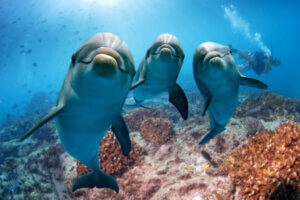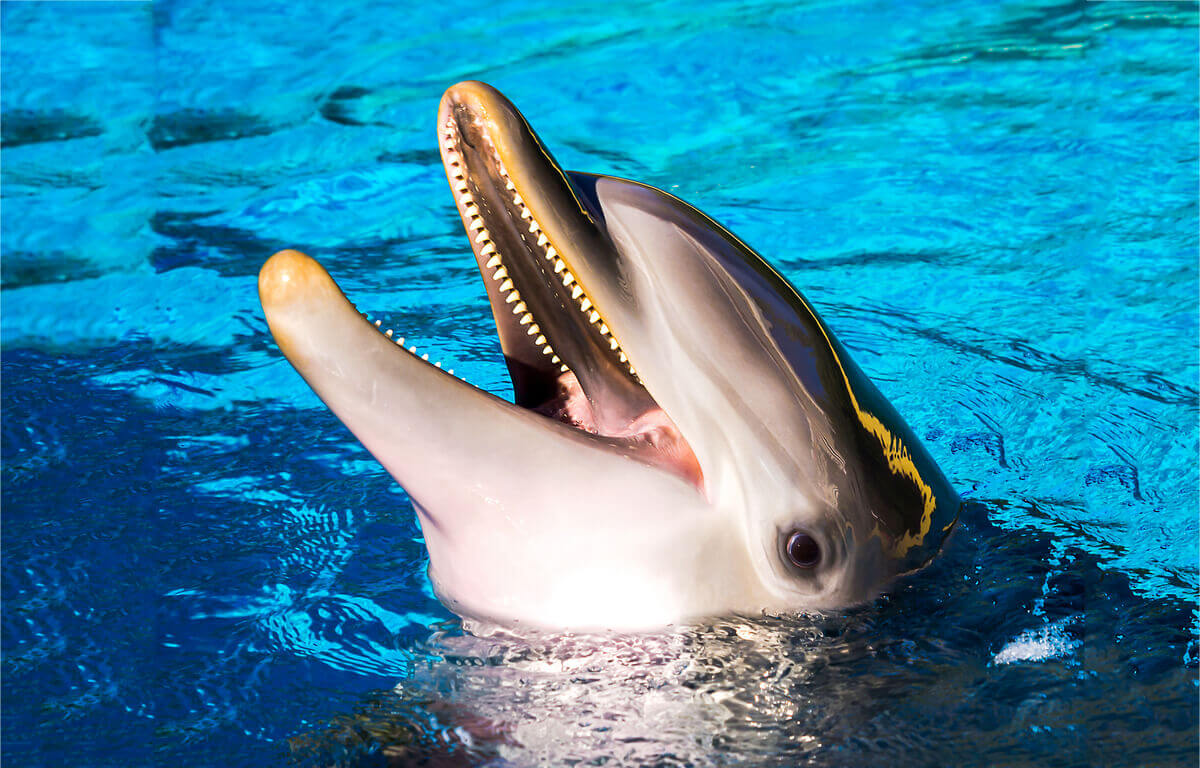Is It True that Dolphins Feel Empathy?

In popular culture, there are countless stories about dolphins saving people from shipwrecks and coming to shores in search of human company. All of this raises a logical question: Do we really mean something to dolphins? Does the fact that these animals pull someone who is drowning out of the water mean that the dolphins feel empathy?
Empathy is a complex mental process that requires a high level of cognitive development – evolutionarily-speaking – and a social mind. Dolphins, despite meeting these requirements, have a reputation for not being as friendly as zoos make us believe. If you’re interested in unraveling this issue, read on.
Empathy and theory of mind
We can define empathy as the cognitive ability of an individual to understand and participate in the feelings of another. Have you ever yawned because you saw someone else do it? Maybe a friend has told you “If you cry, then I’ll cry”. All of this is empathy: feeling what the other person’s feeling.
Empathy emerges as an adaptive process in social species, since it’s one of the most sophisticated mechanisms for coexistence among individuals. Without it, group cohesion is impossible to achieve. Furthermore, the requirements for empathy also include a generalized self-awareness among the different members of the association.
This projection of self-awareness is what we know of as the theory of mind. A good example would be to play a specific song for a friend who’s having a hard time because we recall how it helped us lift our own spirits. We’re assuming that, in their mind, the same process will occur as in ours.

Dolphins and the theory of mind
Dolphins have proven to be able to recognize themselves in the mirror, have a complex social system, and possess highly sophisticated communication. But what about the theory of mind? Do dolphins attribute their mental states to others?
The answer is yes. In 2010, Uwano and his group of researchers demonstrated this in an experiment in which dolphins, trained to follow a series of commands through gestures, were more likely to respond to the direction of the caregiver’s gaze than to the gesture itself.
That is, the dolphins paid more attention to what they thought their caretaker wanted than to the order itself. Given all this, can we go so far as to say that dolphins feel empathy? The answer is yes. Here’s how researchers finally demonstrated this fact.
Dolphins feel empathy and act accordingly
Empathy is a process that scientists have already detected in a wide variety of non-human species, from small mice to elephants. But we’ve no choice but to study it through indirect observations, that is, based on its consequences. How does one demonstrate that they feel empathy? The answer is very simple: through helpful behavior.
Before carrying out any experiment, there was already suspicion that dolphins are empathic. For example, just take a look at the very clear evidence below:
- Diving in areas where there are dolphins is relatively dangerous, but not because they can attack you. Dolphins know that humans don’t breathe underwater and try to save divers, thinking they’re drowning. The abrupt change of pressure that occurs by returning to the surface too fast can produce damage to the human body.
- Dolphins defend other species from sharks. These large fish are the natural enemy of dolphins and there are several stories about how they defend swimmers from shark attacks or act as bait to keep them away from groups of whales.
- Dolphins help their fellow creatures. When a dolphin in the group is too weak or injured, the other members of the group swim around to protect it. That way, they help it rise to the surface so it can breathe.
More evidence that reveals that dolphins feel empathy
At the same time, in controlled environments and experimental conditions, researchers have discovered the following regarding empathy in these animals:
- The enormous complexity of their social system is a breeding ground for empathy. The large brain of the dolphins and their prolonged childhood create perfect conditions for developing a sense of group cohesion and acting accordingly.
- The mother-child relationship is key to the development of empathy in dolphins. Mothers teach their calves how to behave in the group, and not only through their behavior. They also do so with their own “words”, since they identify themselves with whistles and talk about each other.
- Their ability to imitate behavior is part of the development of empathy. In comparative psychology studies, researchers observed that the dolphin calf developed empathy for other members of the group by imitating its mother’s behavior.

Conclusion
In conclusion, we want to cite the famous anthropologist and environmentalist Loren Eiseley. He spoke of “ending the long solitude”, where the human species, after thousands of years, gets rid of the feeling of isolation that comes with believing that we’re the only intelligent beings that exist. And you? What do you think?
In popular culture, there are countless stories about dolphins saving people from shipwrecks and coming to shores in search of human company. All of this raises a logical question: Do we really mean something to dolphins? Does the fact that these animals pull someone who is drowning out of the water mean that the dolphins feel empathy?
Empathy is a complex mental process that requires a high level of cognitive development – evolutionarily-speaking – and a social mind. Dolphins, despite meeting these requirements, have a reputation for not being as friendly as zoos make us believe. If you’re interested in unraveling this issue, read on.
Empathy and theory of mind
We can define empathy as the cognitive ability of an individual to understand and participate in the feelings of another. Have you ever yawned because you saw someone else do it? Maybe a friend has told you “If you cry, then I’ll cry”. All of this is empathy: feeling what the other person’s feeling.
Empathy emerges as an adaptive process in social species, since it’s one of the most sophisticated mechanisms for coexistence among individuals. Without it, group cohesion is impossible to achieve. Furthermore, the requirements for empathy also include a generalized self-awareness among the different members of the association.
This projection of self-awareness is what we know of as the theory of mind. A good example would be to play a specific song for a friend who’s having a hard time because we recall how it helped us lift our own spirits. We’re assuming that, in their mind, the same process will occur as in ours.

Dolphins and the theory of mind
Dolphins have proven to be able to recognize themselves in the mirror, have a complex social system, and possess highly sophisticated communication. But what about the theory of mind? Do dolphins attribute their mental states to others?
The answer is yes. In 2010, Uwano and his group of researchers demonstrated this in an experiment in which dolphins, trained to follow a series of commands through gestures, were more likely to respond to the direction of the caregiver’s gaze than to the gesture itself.
That is, the dolphins paid more attention to what they thought their caretaker wanted than to the order itself. Given all this, can we go so far as to say that dolphins feel empathy? The answer is yes. Here’s how researchers finally demonstrated this fact.
Dolphins feel empathy and act accordingly
Empathy is a process that scientists have already detected in a wide variety of non-human species, from small mice to elephants. But we’ve no choice but to study it through indirect observations, that is, based on its consequences. How does one demonstrate that they feel empathy? The answer is very simple: through helpful behavior.
Before carrying out any experiment, there was already suspicion that dolphins are empathic. For example, just take a look at the very clear evidence below:
- Diving in areas where there are dolphins is relatively dangerous, but not because they can attack you. Dolphins know that humans don’t breathe underwater and try to save divers, thinking they’re drowning. The abrupt change of pressure that occurs by returning to the surface too fast can produce damage to the human body.
- Dolphins defend other species from sharks. These large fish are the natural enemy of dolphins and there are several stories about how they defend swimmers from shark attacks or act as bait to keep them away from groups of whales.
- Dolphins help their fellow creatures. When a dolphin in the group is too weak or injured, the other members of the group swim around to protect it. That way, they help it rise to the surface so it can breathe.
More evidence that reveals that dolphins feel empathy
At the same time, in controlled environments and experimental conditions, researchers have discovered the following regarding empathy in these animals:
- The enormous complexity of their social system is a breeding ground for empathy. The large brain of the dolphins and their prolonged childhood create perfect conditions for developing a sense of group cohesion and acting accordingly.
- The mother-child relationship is key to the development of empathy in dolphins. Mothers teach their calves how to behave in the group, and not only through their behavior. They also do so with their own “words”, since they identify themselves with whistles and talk about each other.
- Their ability to imitate behavior is part of the development of empathy. In comparative psychology studies, researchers observed that the dolphin calf developed empathy for other members of the group by imitating its mother’s behavior.

Conclusion
In conclusion, we want to cite the famous anthropologist and environmentalist Loren Eiseley. He spoke of “ending the long solitude”, where the human species, after thousands of years, gets rid of the feeling of isolation that comes with believing that we’re the only intelligent beings that exist. And you? What do you think?
All cited sources were thoroughly reviewed by our team to ensure their quality, reliability, currency, and validity. The bibliography of this article was considered reliable and of academic or scientific accuracy.
Pérez-Manrique, A. & Gomila, A. “False belief attribution in bottlenose dolphins (Tursiops truncatus)
using a novel paradigm”. Oral presentation. Behaviour 2015. 9–14 August 2015. Cairns,
Australia.
Morrison, R. (2018, 10 enero). Precocious development of self-awareness in dolphins. Plos One. https://journals.plos.org/plosone/article?id=10.1371/journal.pone.0189813
Uwano, Y., Ogura, S., & Saito, T. (2010). Bottlenose Dolphins’ (Tursiops truncatus) Theory of Mind as Demonstrated by Responses to their Trainers’ Attentional States. International Journal of Comparative Psychology, 23. https://escholarship.org/content/qt2dd258ps/qt2dd258ps.pdf
This text is provided for informational purposes only and does not replace consultation with a professional. If in doubt, consult your specialist.








